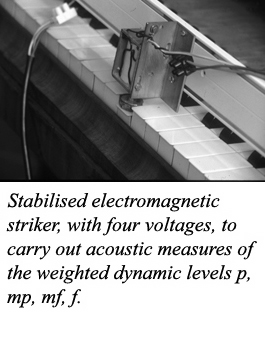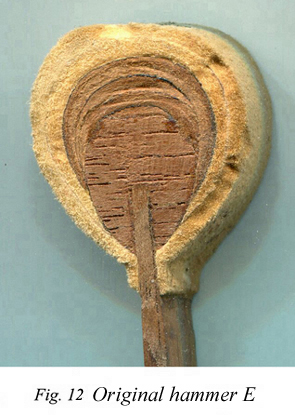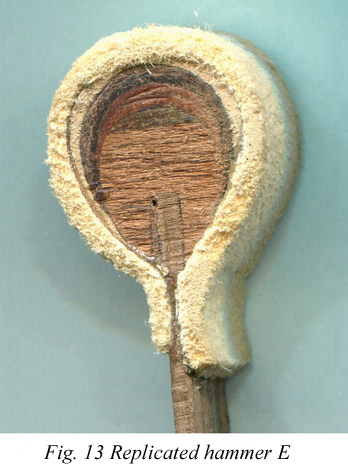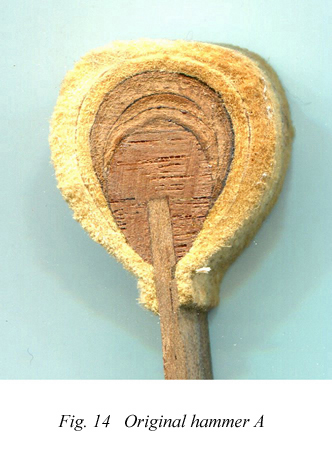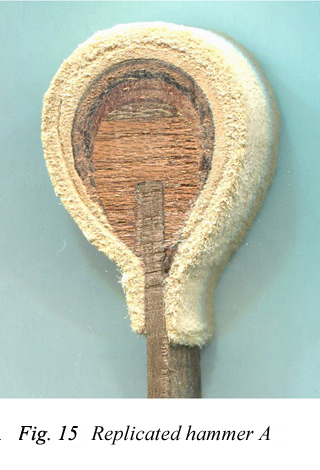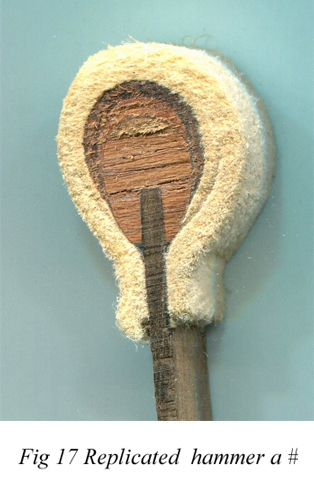CLEMENTI GRAND-PIANO N. 931
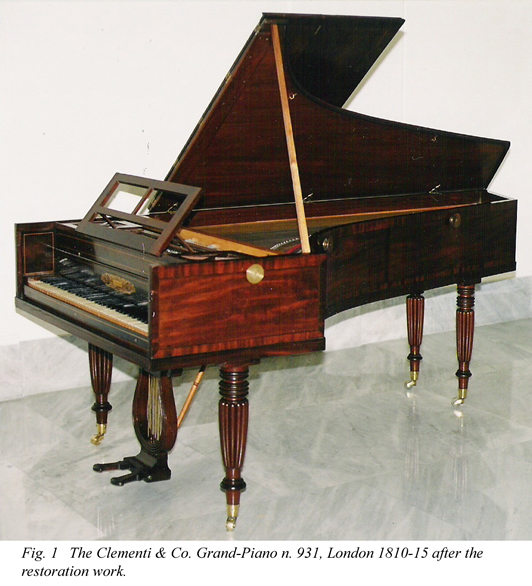 The Clementi grand piano n. 931, of the Santa Cecilia Conservatoire, Rome (fig. 1), which was made in London right at the beginning of the nineteenth century, is a rare example of a concert grand by the piano-makers and musical scores firm (fig. 2) founded in 1798 by Muzio Clementi, "father of the pianoforte".
The Clementi grand piano n. 931, of the Santa Cecilia Conservatoire, Rome (fig. 1), which was made in London right at the beginning of the nineteenth century, is a rare example of a concert grand by the piano-makers and musical scores firm (fig. 2) founded in 1798 by Muzio Clementi, "father of the pianoforte".
Other partners came and went, but the brand remained active until 1832.
Around 1999-2002, when I was finishing restoring this instrument, I proposed dating it to the time-window 1810-15, going by a later instance of Clementi grand pianos, six full octaves in span (see also Martha Novak Clinkscale: Makers of the piano 1700-1821, Oxford University Press 1993).
Certain remarks in Clementi’s letters later caused me to think again, for they suggest that as early as 1803 his firm marketed grand pianos “with extra top notes". Likewise the rather primitive “english grand action” of this instrument argues for dating it to the very first years of the nineteenth century: the mechanism completely lacks hinges for the escapements, which simply pivot in holes bored in the keys.
This deluxe pianoforte n. 931, 234 cm long, is probably the one Clementi gave to his niece Maria Felice, who lived in Rome, as mentioned in a letter to his brother Gaetano, dated London, 12 March 1802: “Please present the Piano e Forte to my dear young niece as a small gift from me…” (see “Muzio Clementi, Epistolario 1781-1831” ed. Remo Giazotto, Accademia nazionale di Santa Cecilia, Roma, 2002, pp.123-24). The letter shows Clementi’s far-sighted interest in the musical development of the girl, whom he would send practical tips for studying the piano. In establishing the original ownership of the instrument, it confers an added historical value.
This piano has an elegant design, with an exterior finish made of mahogany and rosewood, rimmed with ebony and maple, and resting upon four tapered solid mahogany legs: this instrument is fully a part of the English style, from which it adopts a typical version of the “English grand action”, a mechanism derived from that of Bartolomeo Cristofori.
Although belonging to the era in which the piano’s timbre was still disengaging itself from the harpsichord-like sonorities, after the acoustic restoration this instrument revealed a full and vibrant sound. According to what J. N. Hummel stated, towards the end of the classical period this element characterised the English style that was then most popular, together with the Viennese one.
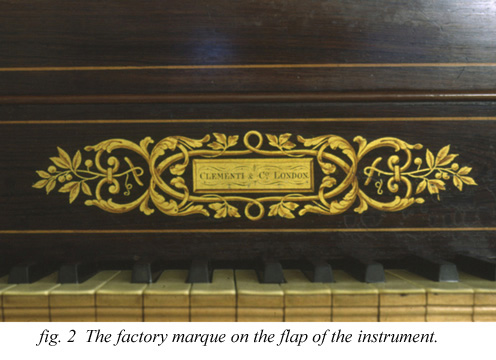 The problem of the excessive disequilibrium in the progression of the range from low to high tones is a recurrent theme in the piano history. This problem was successfully overcome in this Clementi instrument thanks to the clever equilibrium between the refined soundboard, the strings (made of iron and brass, developing on the wooden frame a combined pull of about 4,500 Kgf.) (figs. 3 and 4), and the action mechanism: the latter is made up of six layers of precious skins, of decreasing hardness, applied to a mahogany core. This clever assembly starts , as in classical lute-making, with a perfect choice in the wood of picea abies (red fir-tree) that constitutes the soundboard, endowed with an exceptionally effective resonance.
The problem of the excessive disequilibrium in the progression of the range from low to high tones is a recurrent theme in the piano history. This problem was successfully overcome in this Clementi instrument thanks to the clever equilibrium between the refined soundboard, the strings (made of iron and brass, developing on the wooden frame a combined pull of about 4,500 Kgf.) (figs. 3 and 4), and the action mechanism: the latter is made up of six layers of precious skins, of decreasing hardness, applied to a mahogany core. This clever assembly starts , as in classical lute-making, with a perfect choice in the wood of picea abies (red fir-tree) that constitutes the soundboard, endowed with an exceptionally effective resonance.
The successful phonic result is congruous to the circumstances that saw in one man, Clementi, the meeting of the impresario-overseer , the pianist and the composer: and in this triple guise Clementi could not help but expect the piano model he himself had created to evoke in an accomplished and meaningful way all the facets of his research into piano lexicography and the nature of the piano: that research was the most systematic one ever realised between Classicism and Romantic aesthetics.

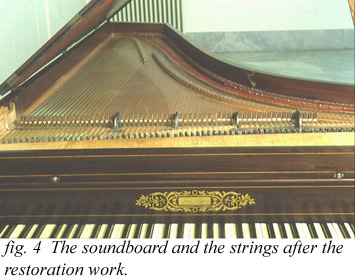
The aesthetic and timbre restoration
Before the restoration this instrument could not be played: the obsolescence of the ‘acoustic machine’ and the loss of many pieces made it completely unusable and the original timbre characteristics unintelligible.
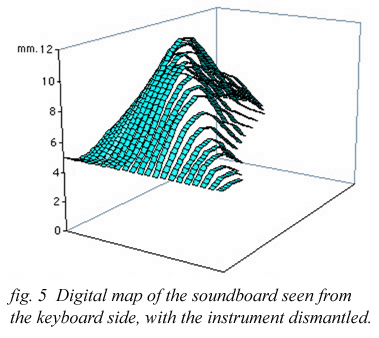 The restoration was performed by Flavio Ponzi within the scope of a long research study into the recovery and re-utilisation of the 19th century pianos. This research aimed to establish an optimum balance between the conservation needs and the elevated parameters of timbre definition and mechanics that are indispensable for the interpretative and concert-hall use of such instruments. The method used by Flavio Ponzi is the result of thorough research presented at international scientific institutions. The results of the restoration are continuously submitted to objective testing, through the quantification of the physical characteristics of the instrument, and the comparative analysis of the wave-patterns and the three-dimensional sound spectra. This method also includes the integration of the missing elements (owing to wear and tear or the history of the instrument) and that are realised as an historical copy, within a painstaking analysis of constructive philology.
The restoration was performed by Flavio Ponzi within the scope of a long research study into the recovery and re-utilisation of the 19th century pianos. This research aimed to establish an optimum balance between the conservation needs and the elevated parameters of timbre definition and mechanics that are indispensable for the interpretative and concert-hall use of such instruments. The method used by Flavio Ponzi is the result of thorough research presented at international scientific institutions. The results of the restoration are continuously submitted to objective testing, through the quantification of the physical characteristics of the instrument, and the comparative analysis of the wave-patterns and the three-dimensional sound spectra. This method also includes the integration of the missing elements (owing to wear and tear or the history of the instrument) and that are realised as an historical copy, within a painstaking analysis of constructive philology.
Overlooking the aspects resulting from the external decay of the piece, commonplace in instruments dating back to that period, it is worth bearing in mind that the most important problems that the restoration had to overcome concerned the loss of 28 hammers (out of 72) and the 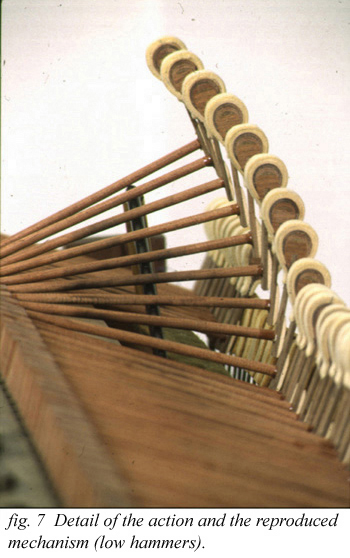 ineffective hold of the holes and the pinblocks of the strings, an element that would have made tuning impossible and therefore the use of the instrument itself.
ineffective hold of the holes and the pinblocks of the strings, an element that would have made tuning impossible and therefore the use of the instrument itself.
The soundboard and the wooden case of this piano had instead remained excellent for nearly two centuries (fig. 5), and is presumably still very similar to the original, an element that demonstrated the exceptional quality of the manufacturing decisions made by Clementi.
It should not be forgotten that through playing the pianist exerts an action that is in itself strongly destructive towards the hammer keysets. In order to provide the best conservative reconstruction in regard to what remained of the original hammer, allowing at the same time for the full 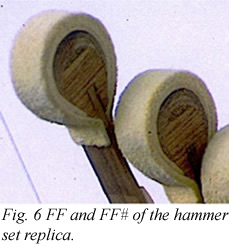 re-use of the instrument, the restoration added the missing 28 hammers to that keyset, in order to allow the timbre characteristics of this invaluable aesthetic item to be fully appreciated. In order to do this the complete replica of the action itself was also made (fig. 6), destined to be used prevalently so that the original action could be protected from further wear. That replica includes the related mechanical part (fig. 7) and to create this very particular device, naturally conceived of very differently from the present-day ones, a special machine was specially dedicated to the construction of the new hammers. This operation interpreted some of the characteristic signs impressed upon the materials by the original process, and the measures and the types of original material have thus been replicated, made up of layers of cowhide and deer skins.
re-use of the instrument, the restoration added the missing 28 hammers to that keyset, in order to allow the timbre characteristics of this invaluable aesthetic item to be fully appreciated. In order to do this the complete replica of the action itself was also made (fig. 6), destined to be used prevalently so that the original action could be protected from further wear. That replica includes the related mechanical part (fig. 7) and to create this very particular device, naturally conceived of very differently from the present-day ones, a special machine was specially dedicated to the construction of the new hammers. This operation interpreted some of the characteristic signs impressed upon the materials by the original process, and the measures and the types of original material have thus been replicated, made up of layers of cowhide and deer skins.
Numerous acoustic tests have been performed to compare the wave patterns of the sounds of the original hammers with those of the reproduced hammers (fig. 8). These tests have proven a very close similarity between the original action mechanism and the replica. The instrument now disposes of two completely functional action mechanisms.
Even for the problem of the pinblock holes a special technique for the reconstruction of the holes was applied, elaborated within this research, which allowed us to completely re-use the original holes, respecting the integrity of the pinblock.
This restoration has laid the foundations for the complete enjoyment of this priceless historical asset, an extraordinary document to the timbre and mechanism of the pianoforte, which Clementi was inspired by in the first two decades of the 19th century.


|
||
|
||
|
NOTE The following samples were recorded immediately after the assembly of the original and new-made hammers to their respective actions (October 2003): the sound of the original hammers (with the leathers rather furrowed by the strings), was obviously a bit brighter than that of the new made hammers, which at the time of the recording were not furrowed at all. |
|
Listen A (original hammer), the fourth level of mechanical percussion
Listen A (replicated hammer), the fourth level of mechanical percussion
|
||
|
||
go to the opening conference and concert
